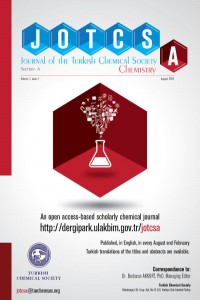Determination of the Dispersive Component of the Surface Energy and Surface Acid / Base Properties of Perlite Using Inverse Gas Chromatography
Abstract
Inverse gas chromatography (IGC) is a derivation of conventional gas chromatography but, unlike analytical chromatography, the material being evaluated is in the stationary phase in the gas chromatography column. IGC has attracted a lot of attention because of its simplicity and the affordability. IGC has become a useful and reliable analytical method because of its relative rapidity, simplicity, and good accuracy, as well as the relatively low cost and availability of the equipment associated with its practice essentially in gas chromatography. IGC may be experimentally configured for finite (finite concentration region) or infinite (Henry’s law region) dilution concentrations of the adsorbate. In this region; the physicochemical properties of solids was investigated using IGC. In the infinite dilution conditions of the IGC method, a few molecules are injected into the column to approach zero surface coverage. Under this condition the lateral interactions between the adsorbed molecules on the surface can be neglected and the thermodynamic functions depend only on the adsorbate–adsorbent interactions. Adsorption can be considered to take place in the linear part of the adsorption isotherms (Henry’s law region). The attainment of the Henry’s law region is indicated by attainment of the Henry’s law region is indicated by the symmetry of the chromatographic peaks and by the constancy of the retention times measured over a significant range of the sample sizes. Hence, the net retention volumes for a given adsorbate are independent of its gas phase concentration [1]
Perlite is finding many uses areas because of technical specifications such as, porosity, lightness, isolative to heat and sound, chemical inertness and the noncombustible. Perlite is much more consumed in the construction industry today. Research on the perlite has focused on production of building materials and examination of the properties of these materials [2].
In the present study, the IGC method at infinite dilution is applied for to investigate the dispersive (London) component of the surface energy ( d γS ) according to Schultz et al. methods. ). For IGC studies, retention time of n-hexane, n-heptane, n-octane and n-nonane were measured at infinite dilution conditions, between 60 and 90 °C. Dispersive component of the surface energy of perlite were calculated as; 34,243, 30,887, 27,644 and 24,573 MJ/m2 respectively. It was observed that, d γS values decrease with increasing temperature. By correlating the specific adsorption enthalpy
of polar probes on perlite with donor and acceptor numbers of the probes, the Lewis acidic (KA) and the Lewis basic (KD) parameters of the sample was calculated. The obtained values for KA and KD were of 0,133 and 0,175. Characterization of perlite was made using Fourier transform infrared spectroscopy (FTIR); 2882-3557 cm-1 areas representing the zeolitic water and containing the coordinated to the magnesium in the octahedral layer bound water. On the other hand, 782 cm-1 at wavelength
vibration of Si-O-Al was observed.
Keywords
References
- Volker A, Strzemiecka B, Adamska K, Milczewska K. INVERSE GAS
- CHROMATOGRAPHY AS A SOURCE OF PHYSIOCHEMĐCAL DATA, Journal of
- Chromatography A, 2009, March 1216 (10):1551–1566.
- Tekin G, PERLIT VE SEPIYOLIT’IN AMONYUMHEPTAMOLIBDAT ILE
- MODIFIKASYONU VE ELEKTROKINETIK ÖZELLIKLERI, Balıkesir Üniversitesi, Fen Bilimleri Enstitüsü Dergisi, 2004, 6(2), 35-49.
Perlitin Yüzey Enerjisinin Dağılım Bileseninin ve Yüzey Asit/Baz Özelliğinin Ters Gaz Kromatografisi ile Belirlenmesi
Abstract
Geleneksel adsorpsiyon tekniklerinin tersine, ters gaz kromatografisi (TGK) yönteminde kolon içerisindeki uçucu olmayan sabit faz incelenmektedir. TGK üzerine yapılan çalısmaların çok fazla olmasının baslıca nedenleri, islemlerin kolaylığı ve ekonomikliğidir. TGK’nin temel ekipmanları, ucuz, basit ve kolay bulunabildikleri için bu yöntemle rutin laboratuvar uygulamalarında olduğu kadar özel ilgi gerektiren temel arastırmalarda da çalısılabilir. TGK ölçümleri hem sonlu yüzey kaplanmasında (sonlu konsantrasyon bölgesi), hem de sonsuz seyrelme bölgesinde (Henry kanunu konsantrasyon bölgesi) gerçeklestirilebilir. Sonsuz seyrelme bölgesinde; katıların fizikokimyasal özellikleri TGK kullanılarak incelenebilir. TGK ile yüzey kaplanmasının sıfıra yaklastığı ve adsorplanan-adsorplanan etkilesmelerinin ihmal edilebileceği, çok düsük buhar konsantrasyonu kosulları altında adsorpsiyon verileri elde edilebilir. Gözlenen termodinamik davranıslar sadece adsorplanan-adsorplayan etkilesimlerine bağlıdır. Adsorpsiyon sonsuz seyrelme bölgesinde yer aldığında; elde edilen kromatografik pikler simetriktir ve alıkonma zamanları enjeksiyon hacminden etkilenmez. Bu Henry kanunu bölgesine ulasıldığının bir göstergesidir [1].
Perlit gözenekliliği, hafifliliği, ısı ve ses yalıtıcılığı, kimyasal inertliği ve yanmazlığı gibi teknik özellikleri nedeniyle birçok kullanım alanı bulmaktadır. Günümüzde daha çok insaat sektöründe tüketilmekte, bu nedenle de perlit hakkındaki arastırmalar insaat malzemelerinin üretimi ve bu malzemelerin özelliklerinin incelenmesi konularında yoğunlasmıstır [2].
Bu çalısmada TGK kullanılarak sonsuz seyrelme bölgesinde perlitin yüzey enerjisinin dağılım bileseni ( d γS ), Schultz metoduna göre belirlenmistir. TGK çalısmalarında apolar test bilesiği olarak dört n-alkan (hegzan, heptan, oktan, nonan) kullanılmıstır. Yüzey enerjisinin dağılım bileseni 60, 70, 80 ve 90 °C’de sırasıyla 34,243, 30,887, 27,644 ve 24,573 mJ/m2 olarak hesaplanmıstır. Perlitin d γS değerinin artan sıcaklıkla azaldığı bulunmustur. Bulunan spesifik adsorpsiyon entalpisi değerlerinden yararlanılarak Lewis yüzey asitlik (KA ) ve bazlık (KD) sabitleri sırasıyla 0,133 ve 0,175 olarak belirlendi. Ayrıca perlit numunesinin, Fourier transform infrared (FT-IR) spektrumu incelendiğinde 2882-3557 cm-1 bölgesinde zeolitik suyu temsil eden ve oktahedral tabakadaki magnezyuma koordine olmus bağlı su bulunduğu, 782 cm-1 dalga boyunda ise Si-O-Al titresimleri gözlenmistir.
Keywords
References
- Volker A, Strzemiecka B, Adamska K, Milczewska K. INVERSE GAS
- CHROMATOGRAPHY AS A SOURCE OF PHYSIOCHEMĐCAL DATA, Journal of
- Chromatography A, 2009, March 1216 (10):1551–1566.
- Tekin G, PERLIT VE SEPIYOLIT’IN AMONYUMHEPTAMOLIBDAT ILE
- MODIFIKASYONU VE ELEKTROKINETIK ÖZELLIKLERI, Balıkesir Üniversitesi, Fen Bilimleri Enstitüsü Dergisi, 2004, 6(2), 35-49.
Details
| Primary Language | Turkish |
|---|---|
| Journal Section | MEETING ABSTRACTS |
| Authors | |
| Publication Date | June 9, 2015 |
| Submission Date | June 5, 2015 |
| Published in Issue | Year 2015 Volume: 2 Issue: 3 |



